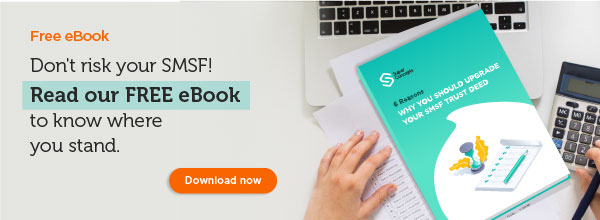
By Graeme Colley
Executive Manager, SMSF Technical & Private Wealth
960a5602d9f24e39a4ca730b0fed0f71.png?sfvrsn=3cf8184a_0)
You might think that an incapacitated SMSF sounds unusual, but it can happen if it is caught between a rock and a hard place and cannot operate or be administered. This can occur if the fund ends up with no trustees or members and no one can legally make decisions about the fund.
It’s highly unlikely, but if all members and trustees of a fund become legally incapacitated or pass away at the same time, there may be no one left to administer the fund. In other situations, a fund may be in a difficult place where the fund members are going through a divorce or have been declared insolvent (bankrupt). These situations can lead to a stalemate and someone needs to be appointed to break the ice and get things going.
The most common situation is where a member or trustee of the fund loses legal capacity or dies. An example would be a fund with a single member/trustee who has not appointed a legal personal representative or someone who has died intestate, that is, without a will.
A legal personal representative is the executor or administrator of a person’s estate, a trustee of a person under a legal disability, or someone granted an enduring power of attorney by the person. So the tip here is for a member or trustee to make a will or grant an enduring power of attorney to a competent person. The attorney can then step into the member or trustee’s place and administer the fund as authorised by the Superannuation Industry (Supervision) Act 1993. Where a person is under a legal disability and does not have a will or enduring power of attorney in place, the public guardian can step in and appoint a person to act as trustee to look after the disabled person’s interests, including their benefits in the SMSF.
A person’s enduring power of attorney is more than a medical power of attorney, which is a specialised type of attorney and relates to the medical welfare of the individual. There is also a general power of attorney which allows you to appoint others to manage your financial and legal decisions on your behalf but only while you are capable of making your own decisions. If you wish to appoint someone to act as a trustee in your place, the SIS Act requires that you appoint an enduring power of attorney. An enduring power of attorney allows you to appoint a person or persons to manage your financial and legal decisions when you are capable of making your own decisions and continues after you have lost mental capacity.
The trust deed of the SMSF may create some roadblocks in the fund’s administration where a single member has died. In some cases the appointment of a trustee may require a resolution or minute from the fund member. Where the sole member has died, difficulties may arise in the appointment of a replacement trustee under the fund’s trust deed. However, under the SIS Act on the death of a member, their legal personal representative may become the individual trustee or director of the corporate trustee from the time the member died until the member’s benefits commence to be paid.
A better solution in this situation may be that the appointment of a trustee under the provisions of the fund’s trust deed be left to the discretion of the remaining trustees. The reason is that a fund with a single member, must have two individuals as trustees, one of whom is not required to be a member. If the fund has a corporate trustee, it can have a single director or two directors, one of whom is not required to be a member. In the circumstances where the corporate trustee has one director, the Corporations legislation will allow the member’s legal personal representative to replace the deceased director. Both alternatives will allow the fund to keep operating, rather than the alternative to seek appointment by the court of an administrator of the member’s estate who may become a trustee of the fund.
The lesson from this is clear: a person should have a will and grant an enduring power of attorney to a person who will be able to look after the SMSF. It has been shown from many court cases that disputes over the control of an SMSF and the payment of benefits that failing to have a will can create no end of problems on the death of a trustee/member.
Another situation where the parties can be at loggerheads is where the members and trustees of the fund are going through a divorce. They may be more concerned with an internecine war rather than drawing a line in the sand, splitting the assets of the relationship, and moving on – no matter how hard that may be. Also, the insolvency or bankruptcy of a member can bring the SMSF to a standstill due to other events in their life.
In a divorce situation, the splitting of assets as part of the drafting of the agreement can lead to delays in making fund investments and lead to compliance issues. This may result in one member/trustee stonewalling the fund’s operation to the detriment of the whole fund.

One member of the SMSF may likely decide to transfer the fund investments to a newly established fund. Once the benefit has been transferred, the fund has up to six months to meet the trustee requirement under the definition of SMSF in section 17A of the SIS Act. If the SMSF previously had two individual members/trustees and one resigned as trustee, it would be necessary to appoint another individual or replace it with a corporate trustee within six months.
The bankruptcy of a member is vital to understanding the implications for the administration of an SMSF. The bankrupt needs to act as soon as declared bankrupt to resign as trustee and roll over their benefit to an APRA fund or have the SMSF converted to a small APRA fund and have an approved trustee appointed. The reason is to ensure the SMSF retains its compliance status and, if required, any replacement trustee is appointed within the required six months.
Often the six-month leeway is something the trustees have not heard of or do not understand. In some situations, the issues may not be recognised until the client lodges information with their accountant, administrator or other professional. This may be well after the six months has been exhausted and could be a long time after the end of the relevant financial year. The trick is to get something done as soon as possible rather than when the documents are provided to the fund’s accountant or an administrator.
An SMSF that is ineffective for any number of reasons can lead to many compliance issues. This can, for example, cause the fund to no longer be classified as an SMSF under the SIS Act or result in problems arising with trustee legislation or implications inherent in the trust deed.


This eBook, written by one of Australia's most trusted SMSF experts, Graeme Colley, uncovers 6 reasons why you should update your trust deed.
To learn more about how our range of SMSF services phone us on 1300 023 170 or request a call back.
Alternatively click through to view our range of services for trustees, accountants and advisers.